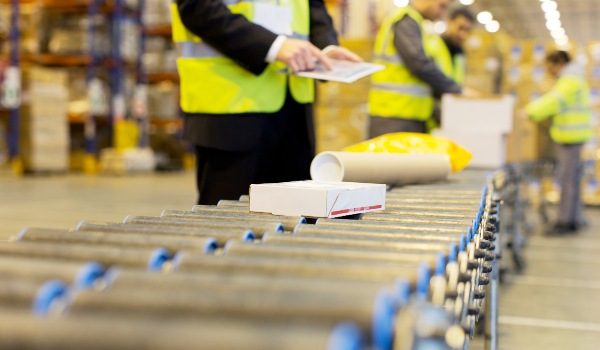“Shaving just 15-20 seconds off each box packed can translate to significant time savings,” says Brian Rowe, OfficeMax Packaging Specialist with two decades of experience in the industry.
“Imagine the boost in efficiency across an 8-hour shift, a daily volume of 100 packages, or even ten packing stations working in tandem.”
Brian lays out ten essentials for a productive and efficient packing station in a warehouse.
1. Optimise your benchtop space: A poorly designed packing table workstation reduces the efficiency of the packing workflow, increases errors and delays, and increases the risk of injuries.
-
Allow enough room on the table for a laptop or a desktop setup (with mouse and keyboard), barcode scanner and label printer (if any).
-
Provide sufficient power points to plug in your electronic devices. Use an extension power board under the table channel to organise cables neatly. It makes the workstation look uncluttered, and you also do not run the risk of a loose connection or accidentally unplugging.
-
Keep sufficient space on the table to pack the largest box.
2. Streamlining with Racks and Drawers: Arrange your tools and items according to the usage hierarchy. Keep frequently used items closer, ideally within arm’s length, and less used items within walking distance of 5-10 steps.
-
Organise your racks: You can arrange small to medium-sized boxes on top racks for easy accessibility. Other small items, such as labels (printer labels or fragile stickers), courier bags, label pouches, packing tapes, and tape dispensers, can be arranged on another rack over the benchtop.
-
Drawer for tools: Use the drawer to keep tools such as measuring tape, scissors, box cutters, staplers, refillables, stationery, etc. Use the draw to store extra tools and accessories, but easily reachable.
-
Use the space under the table resourcefully: You can neatly arrange the space below the table to arrange large boxes, void fill, a small bin, your footrest, etc.

3. Void fill: Void fill is integral to keeping your product safe and minimising any damage during shipping. Whether using air pillows, bubble wraps, newsprint, wrapping paper, etc., you can place them under the table, on an adjacent table at an arm’s length distance, overhead, or on a wall mount, such as an LDR Overhead Air Pillow machine.
4. Strapping and taping machines: Handheld strapping and taping machines can be placed around the corner of the workstation, but table-based strapping or taping machines can be placed on the left or right side of the workstation to strap your boxes.
5. Waste management: Depending on the type of products you are packing, you should keep at least two to three waste bins around the packing station: one for cardboard and paper recycling, one for general waste, and the third one for soft plastic recycling, such as bubble wrap, packing tape, plastic bags, etc.
6. Packed boxes: Position your crates or pallets to assemble all packed boxes within walking distance. This will save precious minutes and reduce the chances of fatigue. Avoid putting them too close to the aisles, corners or walking path as it increases the chances of injuries for workers.
7. Space out: Design your workstation or a set of workstations to allow adequate walking and moving space so workers do not run into each other’s territories and disturb work.

8. Safety and ergonomics: An anti-fatigue mat, ergonomic chair, hi-vis jacket, gloves, steel-cap shoes, and retractable cutters are some of the key essentials to keeping warehouse workers safe.
It is also a good idea to designate a walking path, safety gates, proper signage around trip hazards, and moving machinery such as forklifts, pallet jacks, cage trolleys, etc.
9. Lighting and ventilation: Good lighting and proper ventilation help workers be comfortable and focused, reduce strain and fatigue, especially during summer, and minimise hazards in the warehouse.

10. Conveyor belt to enhance workflow: It automates the packing process, reduces the load on the workers to carry items or boxes from one place to another, and allows them to concentrate on picking and packing the boxes.
By implementing these simple strategies, you can create a workstation that streamlines workflow and elevates the productivity of your warehouse staff.
You can also consider innovative tools such as adjustable workstations, hands-free scanners, and sustainable packaging elements that will further optimise your packing operation.
Talk to a packaging specialist who can examine your tools, understand your business needs, and guide you in your quest to be more economical and sustainable.